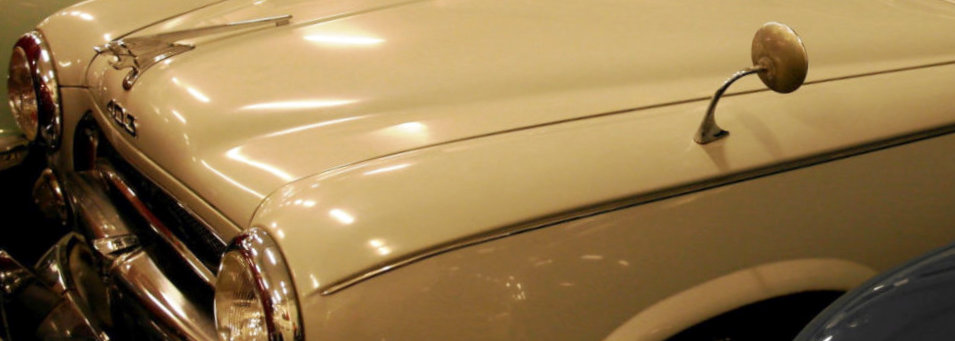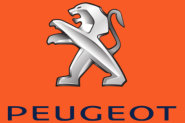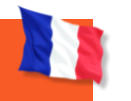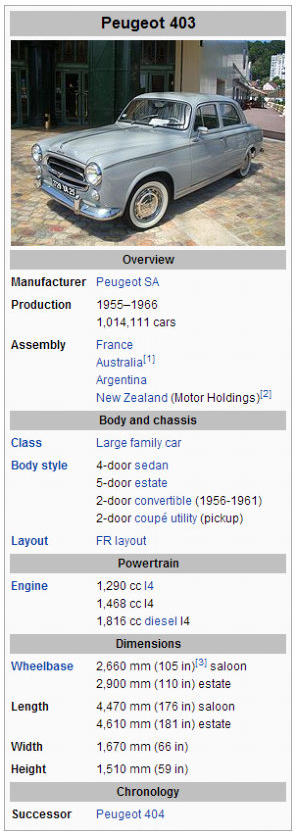












Styled by Pininfarina

Peugeot 403 - 58
The Peugeot 403 is a car produced by French automobile
manufacturer Peugeot between May 1955 and October
1966. It was the first Peugeot to break through the one
million barrier, with 1,014,111 produced (not including
light truck/light van versions).
History
The 403 made its debut in saloon body style on 20 April 1955 at the Trocadéro Palace in Paris. The engine size gave the car a "tax horsepower" of 8 CV (8 hp), which placed it a class below
The engine size gave the car a "tax horsepower" of 8 CV (8 hp), which placed it a class below the soon-to-be-replaced 11 CV Citroën Traction, but at least one class above the small cars
the soon-to-be-replaced 11 CV Citroën Traction, but at least one class above the small cars produced by the principal competitor manufacturers.
When it was first shown, and until after 1958, the leading edge of car's nose carried an
produced by the principal competitor manufacturers.
When it was first shown, and until after 1958, the leading edge of car's nose carried an angular, forward-leaning chrome lion bonnet ornament – the lion image being Peugeot's trade
angular, forward-leaning chrome lion bonnet ornament – the lion image being Peugeot's trade mark. That was removed for 1959, due to safety concerns, and the logo was incorporated
mark. That was removed for 1959, due to safety concerns, and the logo was incorporated into a shield-shaped grill emblem.
into a shield-shaped grill emblem. Subsequently the semaphore-style trafficators on the C-pillars were replaced with flashing
Subsequently the semaphore-style trafficators on the C-pillars were replaced with flashing indicators within the light cluster. The front lights were modified to conform to new
indicators within the light cluster. The front lights were modified to conform to new standards and in 1957 parallel windscreen wipers were substituted for the original "cross
standards and in 1957 parallel windscreen wipers were substituted for the original "cross hands" ones featured at launch.
Although the car was subject to various improvements during the production run, these were
mostly very minor in nature. Improvements for 1959 included moving the nozzles for the
hands" ones featured at launch.
Although the car was subject to various improvements during the production run, these were
mostly very minor in nature. Improvements for 1959 included moving the nozzles for the windscreen washer from the strip of metal between the base of the windscreen and the
windscreen washer from the strip of metal between the base of the windscreen and the bonnet/hood a short distance to the rear edge of the bonnet/hood itself, thus presumably
bonnet/hood a short distance to the rear edge of the bonnet/hood itself, thus presumably improving the angles at which the washer water hit the screen. This was also the year that
improving the angles at which the washer water hit the screen. This was also the year that the semi-circular ring inside the lower half of the diameter of the steering wheel used to
the semi-circular ring inside the lower half of the diameter of the steering wheel used to operate the horn was replaced by a full circular horn-ring, so that drivers accustomed to
operate the horn was replaced by a full circular horn-ring, so that drivers accustomed to holding the upper half of the steering wheel did not need to loosen their grip in order to
holding the upper half of the steering wheel did not need to loosen their grip in order to sound the horn.
sound the horn.
Design
Styled by Pininfarina, the 403 featured ponton, three-box styling incorporating, except on the most basic models, an opening roof panel.
the most basic models, an opening roof panel.
Engine
The 403 came with an enlarged version of the Peugeot 203's 1290 cc petrol engine. Displacing 1,468 cc, the straight-four unit employed pushrod-actuated valves and hemispherical
1,468 cc, the straight-four unit employed pushrod-actuated valves and hemispherical combustion chambers and a crossflow cylinder head to produce 65 hp (48 kW) at about 5,000
combustion chambers and a crossflow cylinder head to produce 65 hp (48 kW) at about 5,000 rpm and 75 lb·ft (102 N·m) of torque at 2,500 rpm. An unusual feature at the time was the
rpm and 75 lb·ft (102 N·m) of torque at 2,500 rpm. An unusual feature at the time was the thermostatically controlled engine fan which cut out when the engine temperature fell to
thermostatically controlled engine fan which cut out when the engine temperature fell to 75°C and reengaged when the engine temperature increased to 84°C. Claimed advantages
75°C and reengaged when the engine temperature increased to 84°C. Claimed advantages included an improvement in fuel consumption of between 5% and 10% according to average
included an improvement in fuel consumption of between 5% and 10% according to average speed and the avoidance, under many conditions, of fan noise. Another little noticed but
speed and the avoidance, under many conditions, of fan noise. Another little noticed but ingenious feature involved a small hot water based heating device for the carburetor linked
ingenious feature involved a small hot water based heating device for the carburetor linked to the heater for the passenger cabin in such a manner that it operated only when the driver
turned on the heater and not when the ambient temperature was high enough for the heater
to be left off.
to the heater for the passenger cabin in such a manner that it operated only when the driver
turned on the heater and not when the ambient temperature was high enough for the heater
to be left off. A diesel powered Peugeot 403 estate was introduced in the Autumn of 1958, the first of a
A diesel powered Peugeot 403 estate was introduced in the Autumn of 1958, the first of a long line, followed by a diesel saloon a year later.
long line, followed by a diesel saloon a year later. Upon the 203's discontinuation in 1960, a 47 hp version of its 1,290 cc powerplant became
Upon the 203's discontinuation in 1960, a 47 hp version of its 1,290 cc powerplant became available as an option on a reduced specification version of the 403, branded initially as the
available as an option on a reduced specification version of the 403, branded initially as the "403 Sept" ("7") and soon afterwards as the "403 Berline Luxe". Car tax in France was based on
"403 Sept" ("7") and soon afterwards as the "403 Berline Luxe". Car tax in France was based on engine size, and the smaller engined 403 fell within the 7CV taxation class rather than the
engine size, and the smaller engined 403 fell within the 7CV taxation class rather than the 8CV of the bigger version.
8CV of the bigger version.
Transmission
The 403 came with a manual 4-speed all-synchromesh transmission driving the rear wheels. The gear change lever stuck out from the right side of the steering column.
For the Paris Motor Show in October 1957 the manufacture offered, at extra cost, an electro-
magnetic Jaeger automatic clutch, activated when changing gear.
The gear change lever stuck out from the right side of the steering column.
For the Paris Motor Show in October 1957 the manufacture offered, at extra cost, an electro-
magnetic Jaeger automatic clutch, activated when changing gear.
Interior
An unusual feature on the inside of the 403 involved the front seats which reclined to the point where the seat backs were flush with the cushions of the rear seat, thus creating a
point where the seat backs were flush with the cushions of the rear seat, thus creating a "couchette", sometimes described in English language sources, optimistically, as a double
"couchette", sometimes described in English language sources, optimistically, as a double bed.
bed.

1958
 Engine
1468 cc
4 cylinders
Power
58 HP
Top speed
130 km/h
Lenght/width
4,47 m/1,67 m
Engine
1468 cc
4 cylinders
Power
58 HP
Top speed
130 km/h
Lenght/width
4,47 m/1,67 m
 The collections car is in good
original driving condition.
The collections car is in good
original driving condition.




Photos mainly by Matti Kreivilä. Historical facts and technical details of the vehicles provided by Wikipedia. Movies YouTube.






